The Intel Core i5-7600K (91W) Review: The More Amenable Mainstream Performer
by Ian Cutress on January 3, 2017 12:01 PM ESTLegacy and Synthetic Tests
At AnandTech, I’ve taken somewhat of a dim view to pure synthetic tests, as they fail to be relatable. Nonetheless, our benchmark database spans to a time when that is all we had! We take a few of these tests for a pin with the latest hardware.
Cinebench R10
The R10 version of Cinebench is one of our oldest benchmarks, with data going back more than a few generations. The benchmark is similar to that of the newest R15 version, albeit with a simpler render target and a different strategy for multithreading.
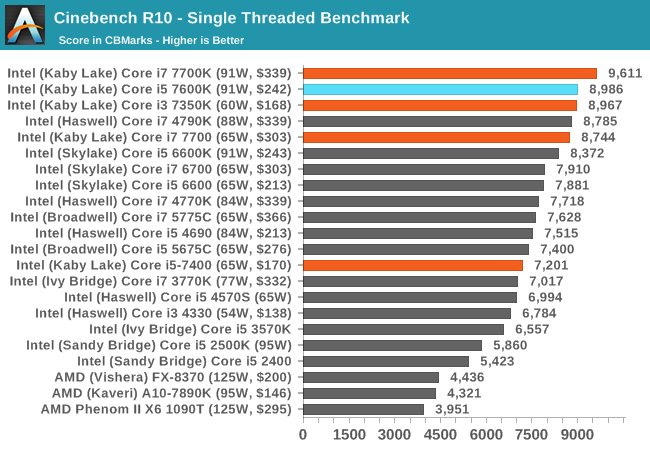
With high frequency in tow, the Core i5-7600K matches that of the previous generation i7-6700K, and goes above the Devil’s Canyon i7 as well.
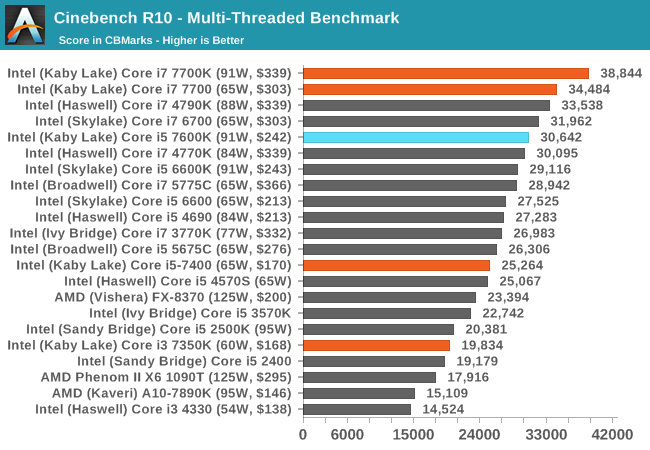
When more threads come to play, the Core i5-7600K sits atop all the other i5 parts, and because hyperthreads have little effect here, the combination of IPC and frequency pushes the Core i5-7600K above previous top performers such as the Core i7-4770K.
Cinebench R11.5
CB11.5 has been popular for many years as a performance test, using easy to read and compare numbers that aren’t in the 1000s. We run the benchmark in an automated fashion three times in single-thread and multi-thread mode and take the average of the results.
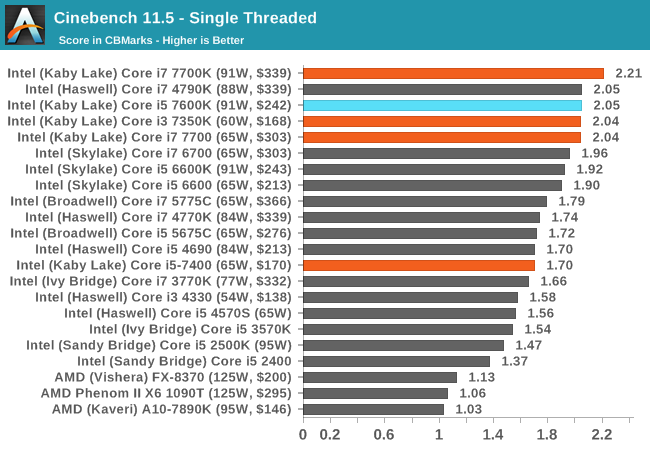

Out of the box the i5-7600K hits above a 2.00 on the single threaded test and above 8.00 on the multithreaded test, showing that the scaling with cores on CB11.5 is very reasonable.
7-zip
As an open source compression/decompression tool, 7-zip is easy to test and features a built-in benchmark to measure performance. As a utility, similar to WinRAR, high thread counts, frequency and UPC typically win the day here.
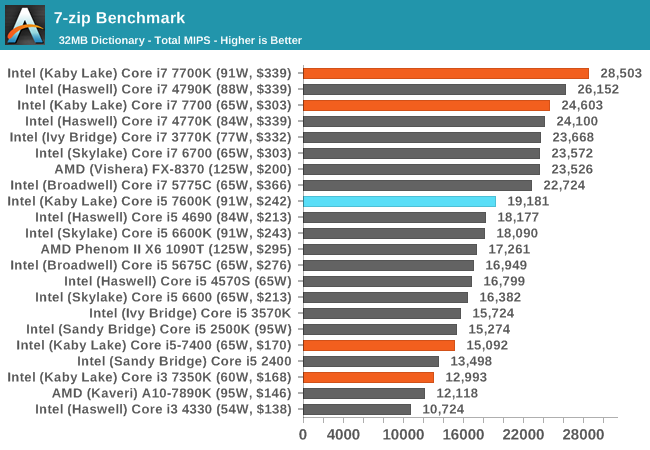
The Core i7-7700K shows the benefits of frequency over a stock i7-6700K, however at the same frequency they perform roughly the same as expected.
POV-Ray
Ray-tracing is a typical multithreaded test, with each ray being a potential thread in its own right ensuring that a workload can scale in complexity easily. This lends itself to cores, frequency and IPC: the more, the better.

AES via TrueCrypt
Despite TrueCrypt no longer being maintained, the final version incorporates a good test to measure different encryption methodologies as well as encryption combinations. When TrueCrypt was in full swing, the introduction of AES accelerated hardware dialed the performance up a notch, however most of the processors (save the Pentiums/Celerons) now support this and get good speed. The built-in TrueCrypt test does a mass encryption on in-memory data, giving results in GB/s.
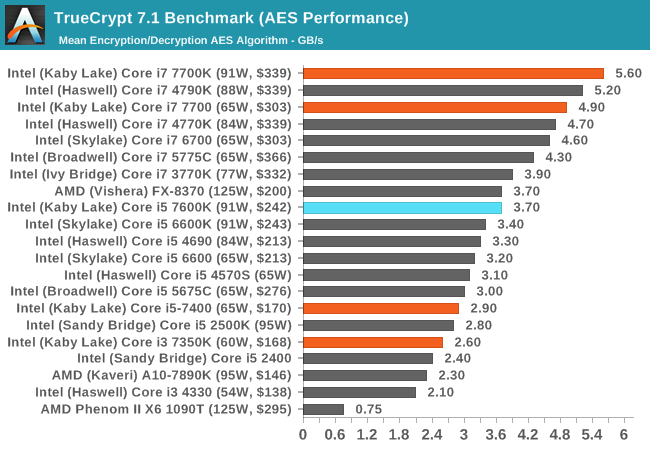










70 Comments
View All Comments
Chaitanya - Tuesday, January 3, 2017 - link
Probably the most useless upgrade in recent years for PC users.Sabresiberian - Tuesday, January 3, 2017 - link
1) This is only an optimization of an existing architecture, and2) Anyone knowledgeable will almost always recommend skipping at least one architectural generation and, especially considering the slow improvements over the last 5 years, at least 2 generations. Which means if you are in a use-case scenario that can take advantage of the increased CPU performance you shouldn't be thinking "upgrade" unless you are running Sandy Bridge or earlier.
(The obvious exception that breaks the rule here is Zen, which will offer a huge performance increase over Bulldozer.)
Shadow7037932 - Wednesday, January 4, 2017 - link
>(The obvious exception that breaks the rule here is Zen, which will offer a huge performance increase over Bulldozer.)How about we wait until it's actually released? Remember what happened with the original Phenom?
silverblue - Wednesday, January 4, 2017 - link
I don't think it's unreasonable to get excited about Zen, at least in terms of AMD's current product lines. Potentially massively optimised benchmarks aside, at least they tested Ryzen engineering samples against Intel's more expensive offerings in public without resorting to slides containing unsubstantiated performance claims. In fact, the only thing I can see in print is the "40% faster than Excavator" claim. If the Canard PC leaks aren't fake, there's every chance that AMD have achieved this, and possibly exceeded it.You mentioned Phenom, so let's take a trip down memory lane:
Phenom: "40% faster than Core 2 Quad at the same clock speed"
Reality: Up to 40% slower per clock after the TLB bug; needed Phenom II to really close the gap.
Bulldozer: "50% faster than the i7 950"
Reality: In what test? Even the 8350 couldn't boast this.
I don't see Ryzen being the gaming top dog - remember, current productivity and gaming demos have been against slower clocked CPUs with double the cores of your garden variety, highly clocked i5 and i7 - but I don't think it's unreasonable to expect that it'll bury the FX series. IMHO, of course.
boozed - Friday, January 6, 2017 - link
I think the problem is that if Skylake wasn't enough of a performance improvement to upgrade, neither is Kaby Lake.Murloc - Tuesday, January 3, 2017 - link
is it?I'm running a nehalem, if I was upgrading now I'd appreciate the lower power consumption and the HEVC hardware support.
willis936 - Wednesday, January 4, 2017 - link
Was HEVC hardware not present on the 6x00 series?Shadow7037932 - Wednesday, January 4, 2017 - link
He said Nehalem, which is the i7 920 and the like.close - Wednesday, January 4, 2017 - link
@Shadow7037932, can you name one good reason why he should update his Nehalem to a Kaby Lake K part that didn't exist one and a half years ago with Skylake?I'll put it another way: If someone passed on a Skylake upgrade last year why exactly would they pay the same price to get a pre-overclocked Skylake (aka Kaby Lake) this year? Why did the user suffer through an extra ~18 months of really aging hardware just to buy what's basically the same CPU at the same price today?
Since these 2 generations share architecture and fabrication process there's no reason to expect consistently better OC on the 7 series. So the 300MHz should be within reach for any K part and any user.
MonkeyPaw - Tuesday, January 3, 2017 - link
Looks like it is the best 14nm Intel architecture you can buy. Still, it seems like if you're in the market now, you might as well wait to see if Ryzen will be a compelling option. If nothing else it might help drive some of these prices down.